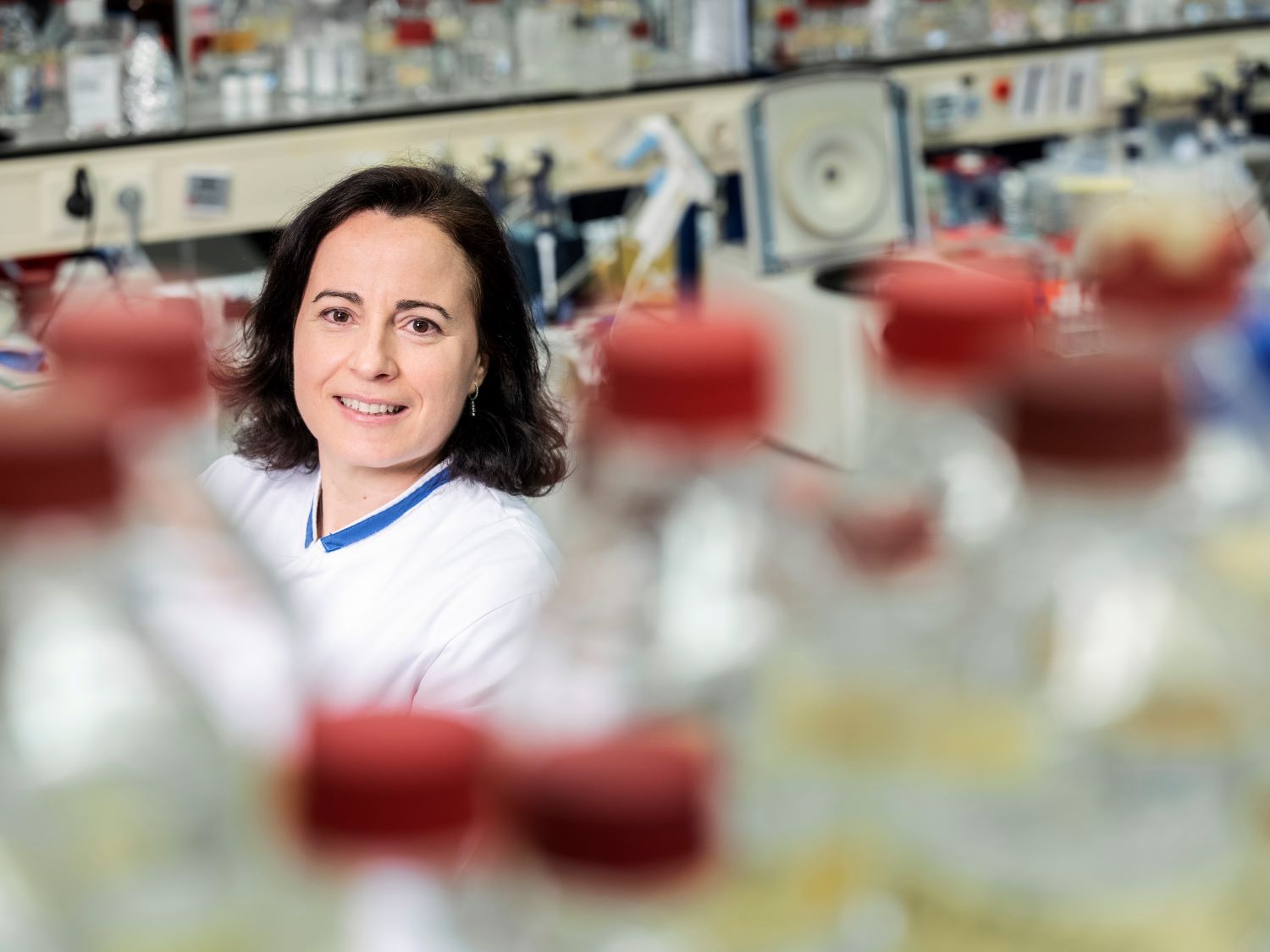‘It happens in half the world’s population without anyone realizing it. And it’s essential to stay healthy. In fact, if it doesn’t happen, it’s deadly. Yet very little is known about it.’ Speaking is Cristina Gontan Pardo, and she talks about a fundamental difference between the sexes, hidden deep in the nucleus of every female cell. A process called X-chromosome inactivation. It is the field in which Cristina started her own research group at the Department of Developmental Biology at Erasmus MC in 2022.
Cows and horses
To understand X-chromosome inactivation, we have to go back to biology class. A boy is born with two sex chromosomes: an X from his mother and a Y from his father. A girl is born with two X chromosomes, one from each parent.
This means that women have two copies of every gene located on the X chromosome compared to one copy in men. To compensate for the double dose, one of the two X chromosomes is turned off in women. This so-called X-inactivation happens very early in development, when a female embryo consists of only a few cells.
‘You can’t have two active X chromosomes, then you’ll die’
X-inactivation is essential for life, Cristina says. ‘You can’t have two active X chromosomes, then you’ll die. You have to switch off one to survive.’ Consequently, we humans are not the only ones who do this. For example, cows, rabbits, mice, cats and horses also do it. It is a universal process in mammals.
That makes it all the more remarkable that very little is actually known about exactly how X-inactivation occurs in women and what consequences it has for their disease susceptibility and health. These are the questions Cristina, herself the mother of 3 daughters and one of 4 sisters, wants to answer with her team.

One thing is already known: X-inactivation happens randomly. Not in every cell the same copy of the X chromosome is switched off. Cristina makes the comparison with a calico cat. ‘There, you can clearly see how that works. The gene that determines whether the fur is orange or black is on the X chromosome. Calico cats are always females, so they have two X chromosomes. Depending on which copy is off in which spot in the coat, you get orange or black spots.
In humans, it’s exactly the same. If you take a small piece of skin, it’s a mix of patches of cells with one or the other X chromosome turned off. ‘If we women would have fur, you could see that we are a mosaic, too,’ Cristina said.
Color blindness
The randomness of X-inactivation also affects health. The best-known example is red-green color blindness. This is much more common in men, because the gene for red-green color blindness is on the X chromosome. If a man has a mutation in that gene, it leads directly to color blindness. After all, he only has one X. If a woman has a mutation in one X chromosome, she always still has the other healthy X chromosome.
Women are thus protected from color blindness by randomly switching off one or the other X in the cells in the eye. ‘Only when women have two X chromosomes with the same mutation does it go wrong,’ Cristina says.
‘Women are more likely to have anxiety , depression and eating disorders’
Color blindness is fairly harmless, but the X chromosome is involved in many more diseases. Cristina especially sets her sights on neurodevelopmental disorders and conditions that are more or less common in women than in men.
She lists: ‘Women are more likely to have anxiety , depression and eating disorders. In men, autism, intellectual disability, dyslexia and ADHD are more common. For a long time it was thought that these differences had something to do with sex hormones and lifestyle. In the last years, we have realized more that it is probably also a due to the different number of X chromosomes.’
Neurodevelopmental disorders
What many of these disorders have in common is that some of the genes involved are on the X chromosome. ‘On the X chromosome there are more than 1,000 genes. Many of them are important for brain development and brain function. That’s why in my research I focus specifically on neurodevelopmental disorders,” Cristina said. But genes involved in metabolism, cancer and immune system also lie on the X chromosome.
All this makes the X chromosome much more crucial than the Y chromosome. On the Y-chromosome lie fewer than 100 genes, which are especially important for male fertility. Living without a Y chromosome is perfectly possible: all women do it.
Cancer
Cristina also sees the link with cancer and the immune system and the X chromosome in her research. ‘This is where my field becomes even more complex, but also even more interesting. Not all the genes on the one X chromosome are turned off. Some remain active. We call those escaping genes.’
Well-known escaping genes, for example, are genes that protect against cancer. ‘That explains the fact that, on average, women get most types of cancer slightly less often than men. Because of the escaping anti-cancer genes on their second X chromosome, they have a double dose of protection.’
Genes important to the immune system also often escape inactivation. Women therefore have a better immune system than men, Cristina explains. ‘This is advantageous because it allows us to fight infections better and vaccines work better. On the other hand, autoimmune diseases are more common in women because their immune systems become overactive.’
Escaping genes
Much is also still unknown about escaping genes. Which genes escape can differ between two people and between different organs of the same person. Or even between the two halves of female identical twins. And then escape can also change over time: the older a person gets, the more genes escape. ‘It could be the cause of age-related diseases in women, but we don’t know for sure yet. It is fascinating stuff, which I would like to discover more about.’

There is also much to learn about the X chromosome and health for her fellow scientists, Cristina notes. “Because I am working on the subject, I often ask other researchers whether the cells they are working with are male or female. They usually have no idea. Sometimes they don’t even know exactly what X-inactivation is. Whereas it’s so important, especially when you’re studying diseases for which the gene is on the X chromosome. If you have female induced pluripotent stem cells derived from patients and you keep then in culture, X-inactivation is generally affected. This is called erosion and it can affect your results without you even realizing it. Sometimes people are shocked when I tell them that.’
‘Now we increasingly realize that sex is fixed in every cell of the body, not just the genitals’
Attention to health differences between men and women is growing in the medical community, Cristina observes. ‘The distinction used to be between the urologist or the gynecologist. Now we increasingly realize that sex is fixed in every cell of the body, not just the genitals.’
Menstrual cycle
She also sees a change in studies of new treatments or drugs. ‘Until now, almost all biomedical research has been done with male subjects or male laboratory animals. Women were excluded, because of the complexity of being a mosaic, the menstrual cycle or damage to a later pregnancy. That was considered too complicated. Nowadays, it is mandatory to include women in clinical studies. Unless you have a good reason not to, for example if you’re researching prostate cancer.’
Cristina’s dream is for women with health problems to be diagnosed and treated as well as men. ‘More focus on women’s health is good. If a woman sees a doctor for chronic pain for which the physical cause is not understood, she is more likely to be prescribed antidepressants. Diseases and processes that occur only in women are less studied, such as endometriosis, fibromyalgia and menopause. Now that is slowly changing. I am very optimistic about that. If I can make a small contribution with my research, I’m happy.’
Start your research career at Erasmus MC. Learn more about our job opportunities.



